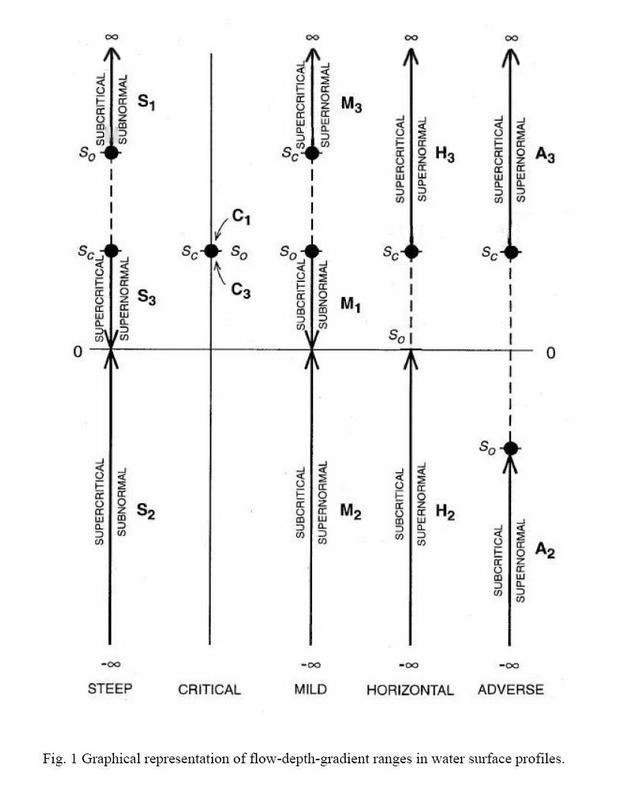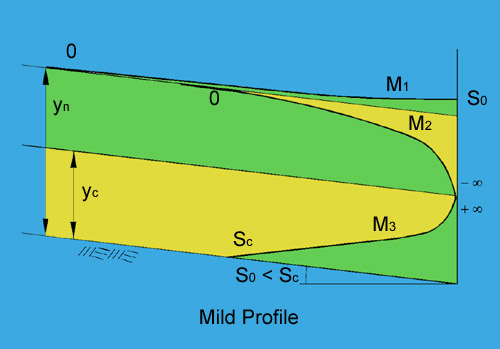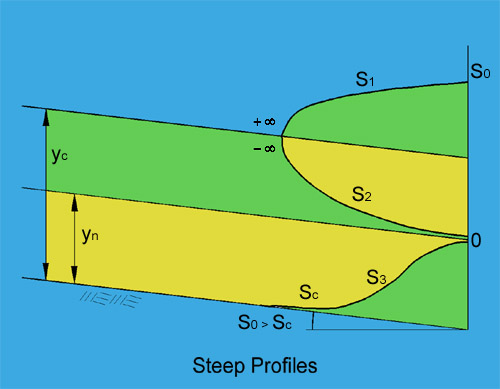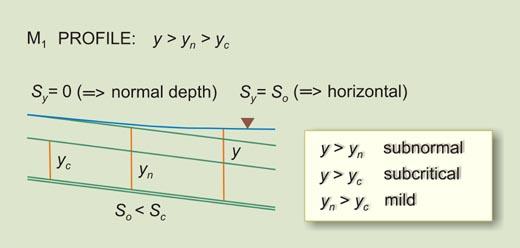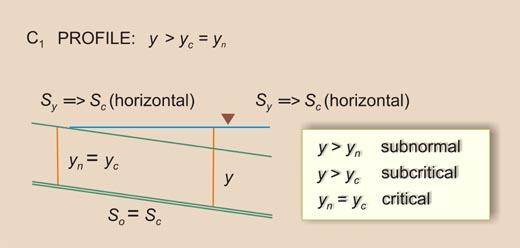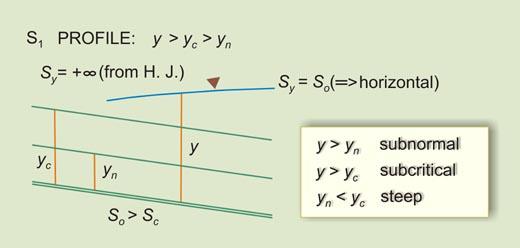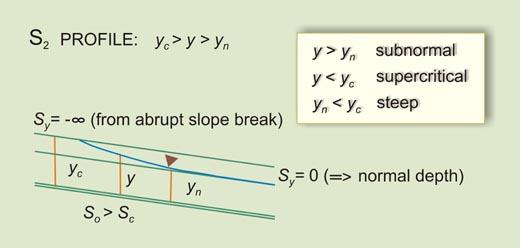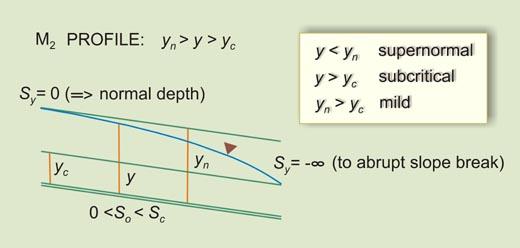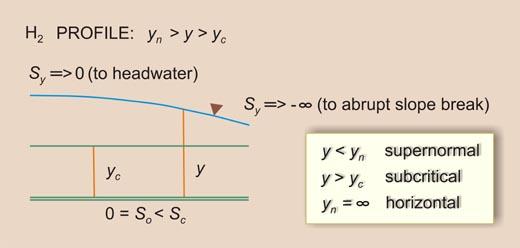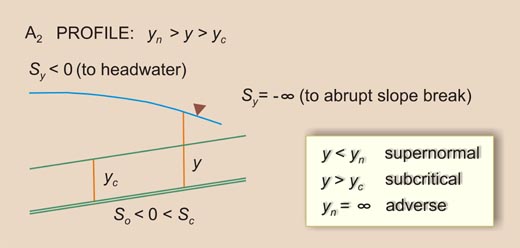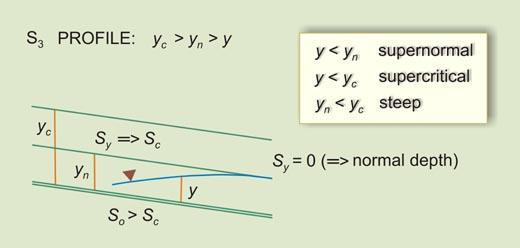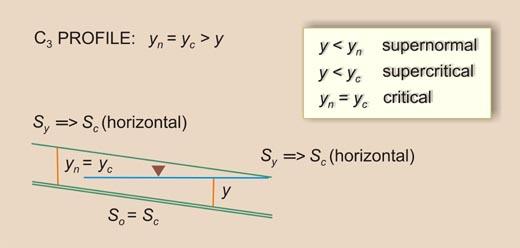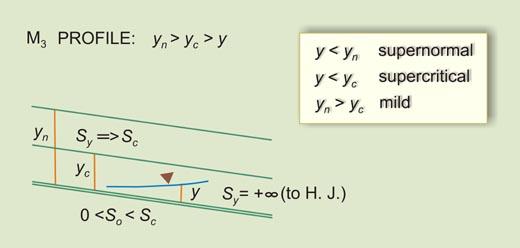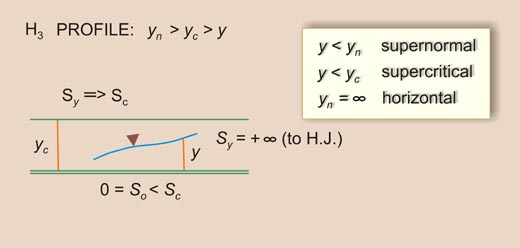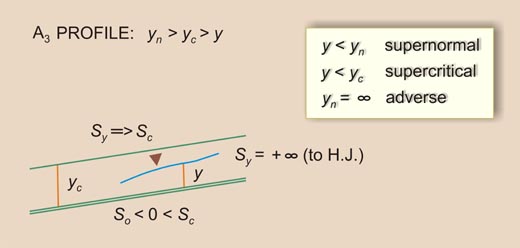|
|
CIVE 530 - OPEN-CHANNEL HYDRAULICS
LECTURE 8B: GRADUALLY VARIED FLOW II
|
|
8.3 CHARACTERISTICS OF FLOW PROFILES
|
- The gradually varied flow equation for hydraulically wide channels is:
|
Sy/Sc = [(So/Sc) - F2] / (1 - F2)
|
- In the LHS of the gradually varied flow equation, Sc is always positive, because friction cannot be zero or negative.
- Therefore, the sign of the LHS will be that of Sy.
- The sign of the LHS can be either
of three (3) possibilities:
- Positive: RETARDED FLOW (BACKWATER).
- Zero: UNIFORM FLOW (NORMAL).
- Negative: ACCELERATED FLOW (DRAWDOWN).
- In the RHS, there are three (3) possibilities for the numerator:
- (So/Sc) > F2 -----> SUBNORMAL
- (So/Sc) = F2 -----> NORMAL
- (So/Sc) < F2 -----> SUPERNORMAL
- In the RHS, there are three (3) possibilities for the denominator:
- 1 > F2 -----> SUBCRITICAL
- 1 = F2 -----> CRITICAL (the equation is undefined)
- 1 < F2 -----> SUPERCRITICAL
- There are three types of families of profiles:
- Type I: Positive.
Both numerator and denominator are positive -----> subnormal/subcritical flow -----> RETARDED FLOW.
- Type II: Negative.
A. Numerator is positive and denominator is negative -----> subnormal/supercritical flow -----> ACCELERATED FLOW.
B. Numerator is negative and denominator is positive -----> supernormal/subcritical flow -----> ACCELERATED FLOW.
- Type III: Positive.
Both numerator and denominator are negative -----> supernormal/supercritical flow -----> RETARDED FLOW.
- In a Type I family (subnormal/subcritical), the rule is:
which is the same as:
(So/Sc can be greater, equal to, or less than 1)
- In the Type I family, there are three profiles:
- M1 -----> So < Sc [1]
- C1 -----> So = Sc [2]
- S1 -----> So > Sc [3]
- In a Type I family, there are not horizontal or adverse profiles because:
Therefore:
- In a Type IIA family (subnormal/supercritical), the rule is:
which is the same as:
(So/Sc can only be greater than 1)
- In the Type IIA family, there is one profile:
- S2 -----> So > Sc [4]
- In a Type IIA family, there are not horizontal or adverse profiles because:
Therefore:
- In a Type IIB family (supernormal/subcritical), the rule is:
which is the same as:
(So/Sc can only be less than 1)
- In the Type IIB family, there are three profiles:
- M2 -----> 0 < So < Sc [5]
- H2 -----> 0 = So < Sc [6]
- A2 -----> So < 0 < Sc [7]
- In a Type III family (supernormal/supercritical), the rule is:
which is the same as:
(So/Sc can be greater, equal to, or less than 1)
- In the Type III family, there are five profiles:
- S3 -----> So > Sc [8]
- C3 -----> So = Sc [9]
- M3 -----> 0 < So < Sc [10]
- H3 -----> 0 = So < Sc [11]
- A3 -----> So < 0 < Sc [12]
|
Table 1. Summary of water surface profiles
|
| Family |
Character |
Rule |
So/Sc > 1 |
So/Sc = 1 |
So/Sc < 1 |
So = 0 |
So < 0 |
| I |
Retarded
(Backwater) |
1 > F2 < (So/Sc) |
S1 |
C1 |
M1 |
- |
- |
| IIA |
Accelerated
(Drawdown) |
1 < F2 < (So/Sc) |
S2 |
- |
- |
- |
- |
| IIB |
Accelerated
(Drawdown) |
1 > F2 > (So/Sc) |
- |
- |
M2 |
H2 |
A2 |
| III |
Retarded
(Backwater) |
1 < F2 > (So/Sc) |
S3 |
C3 |
M3 |
H3 |
A3 |
|
8.4 LIMITS TO THE WATER SURFACE PROFILES
|
- The flow depth gradient is:
|
dy/dx = (So - Sc F2) / (1 - F2)
|
|
Sy = (So - Sc F2) / (1 - F2)
|
|
F2 = (So - Sy) / (Sc - Sy)
|
- For uniform flow: Sy = 0. The previous equation leads to:
- For gradually varied flow, the equation remains:
|
F2 = (So - Sy) / (Sc - Sy)
|
- There are three cases:
- I. F2 > 0
- II. F2 = 0
- III. F2 < 0
- Case I (F2 > 0) occurs when:
We conclude that Sy has to be either less than both So and Sc, or greater than both.
- Case II (F2 = 0) leads to So = Sy
|
(z1 - z2)/L = (y2 - y1)/L
|
- This depicts a reservoir.
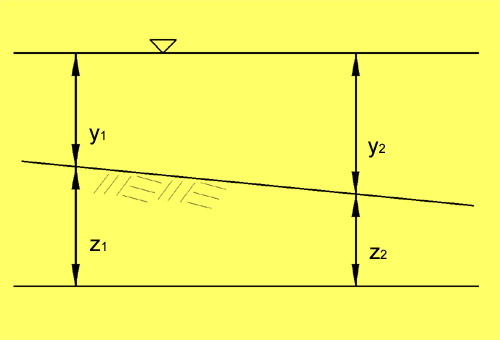
A reservoir.
|
- Case III (F2 < 0) is impossible:
- So > Sy and Sy > Sc
The following inequality is NOT satisfied: So > Sy > Sc
- So < Sy and Sc > Sy
The following inequality is NOT satisfied: So < Sy < Sc
We conclude that Sy cannot be less than one and greater than the other slope (So and/or Sc).
Sy has to be either less than both So and Sc, or greater than both (see Case I).
- Case I (F2 > 0) can have three subcases:
- F2 < 1 -----> So - Sy < Sc - Sy
Leads to: So < Sc subcritical flow
- F2 = 1 -----> So - Sy = Sc - Sy
Leads to: So = Sc critical flow
- F2 > 1 -----> So - Sy > Sc - Sy
Leads to: So > Sc supercritical flow
|
